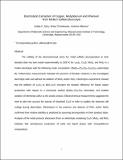Electrolytic Extraction of Copper, Molybdenum and Rhenium from Molten Sulfide Electrolyte
Author(s)
Sahu, Sulata K.; Chmielowiec, Brian John; Allanore, Antoine
DownloadAccepted version (1.232Mb)
Publisher with Creative Commons License
Publisher with Creative Commons License
Creative Commons Attribution
Terms of use
Metadata
Show full item recordAbstract
The validity of the electrochemical series for metal sulfides decomposition in their standard state has been tested experimentally at 1500 K for La₂S₃, Cu₂S, MoS₂, and ReS₂ in a molten electrolyte with the following molar composition: (BaS)₅₄₋(Cu₂S)₃₁₋(La₂S₃)₁₅ (electrolyte B). Voltammetry measurements indicated the presence of faradaic reactions in the investigated electrolyte with and without the addition of MoS₂ and/or ReS₂. Electrolysis experiments showed that the addition of La₂S₃ to BaS-Cu₂S increases the faradaic efficiency for liquid copper production with respect to a previously studied (BaS)₅₄₋(Cu₂S)₄₆ electrolyte, and enabled isolation of elemental sulfur as the anodic product. Electrochemical measurements suggested the need to take into account the activity of dissolved Cu₂S in order to explain the observed cell voltage during electrolysis. Electrolysis in the presence and absence of ReS₂ and/or MoS₂ confirmed their relative stability as predicted by assuming decomposition in their standard states. Analysis of the metal products electrowon from an electrolyte containing Cu₂S, MoS₂, and ReS₂ indicated the simultaneous production of solid and liquid phases with nonequilibrium compositions.
Date issued
2017-07Department
Massachusetts Institute of Technology. Department of Materials Science and Engineering; MIT Materials Research LaboratoryJournal
Electrochimica Acta
Publisher
Elsevier BV
Citation
Sahu, Sulata K. et al. "Electrolytic Extraction of Copper, Molybdenum and Rhenium from Molten Sulfide Electrolyte." Electrochimica Acta 243 (July 2017): 382-389. © 2017 Elsevier Ltd
Version: Author's final manuscript
ISSN
0013-4686